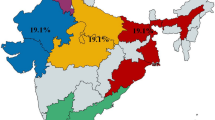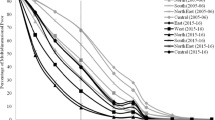Abstract
Using a novel district-level dataset of three poverty indicators and related determinants, this paper attempts to examine the convergence process in terms of poverty reduction across 514 districts over the 2010–2018 period. The main findings of this study are fourfold. First, results of both distributional convergence and spatial convergence analyses suggest that poverty convergence takes place in all three poverty indicators. Second, there is an overall clustering pattern and a persistent West–East polarization in terms of poverty indicators. In addition, decreasing patterns of poverty inequality are significantly associated with increasing patterns of spatial dependence. Third, spatial effects are significantly low in accelerating convergence rates in poverty reduction. However, substantial differences in the speed of convergence among three poverty indicators is apparent. Under specifications of the Spatial Durbin Model as the best model, convergence regression in poverty rate model appears to generate the longest half-life for the catching-up process in poverty reduction across districts. Fourth, regression results from the spatial convergence framework suggest that mean years of schooling tend to contribute the largest effect to the catching-up process in poverty reduction.








Similar content being viewed by others
References
Aginta H, Gunawan AB, Mendez C (2020) Regional Income Disparities and Convergence Clubs in Indonesia: New District-Level Evidence 2000–2017. MPRA Paper 99079, University Li- brary of Munich, Germany. https://ideas.repec.org/p/pra/mprapa/99079.html
Amaghouss J, Ibourk A (2020) Toward a spatial approach for convergence: regional inequalities in term of multidimensional poverty in Morocco. Int J Dev Issues 19(2):187–204. https://doi.org/10.1108/IJDI-07-2019-0131
Anselin L (1995) Local indicators of spatial association—LISA. Geogr Anal 27(2):93–115
Anselin L, Sridharan S, Gholston S (2007) Using exploratory spatial data analysis to leverage social indicator databases: the discovery of interesting patterns. Soc Indic Res 82(2):287–309. https://doi.org/10.1007/s11205-006-9034-x
Arbia G, Basile R, Piras G (2011) Using spatial panel data in modelling regional growth and convergence. SSRN Electr J. https://doi.org/10.2139/ssrn.936321
Balisacan AM, Pernia EM, Asra A (2003) Revisiting growth and poverty reduction in Indonesia: what do subnational data show? Bull Indones Econ Stud 39(3):329–351. https://doi.org/10.1080/0007491032000142782
Barro RJ (1991) Sala-I-Martin X (1991) convergence across states and regions. Brook Pap Econ Act 1:107. https://doi.org/10.2307/2534639
Barro RJ, Sala-I-Martin X (1992) Convergence. J Polit Econ 100(2):223–251
Bidani B, Ravallion M (1993) A regional poverty profile for Indonesia. Bull Indonesian Econ Stud. https://doi.org/10.1080/00074919312331336451
Dartanto T, Otsubo S (2013) Measurements and determinants of multifaceted poverty:absolute, relative, and subjective poverty in Indonesia. Working Papers (54). http://ideas.repec.org/p/jic/wpaper/54.html
Day J, Ellis P (2014) Urbanization for everyone: benefits of urbanization in Indonesia’s Rural regions. J Urban Plan Dev 140(3):04014006. https://doi.org/10.1061/(asce)up.1943-5444.0000164
Day J, Lewis B (2013) Beyond univariate measurement of spatial autocorrelation: disaggregated spillover effects for Indonesia. Ann GIS 19(3):169–185. https://doi.org/10.1080/19475683.2013.806353
Elhorst JP (2003) Specification and estimation of spatial panel data models. Int Reg Sci Rev 26(3):244–268. https://doi.org/10.1177/0160017603253791
Fingleton B (1999) Estimates of time to economic convergence: an analysis of regions of the European Union. Int Reg Sci Rev 22(1):5–34
Fingleton B, Lo´pez-Bazo E, (2006) Empirical growth models with spatial effects. Papers Reg Sci 85(2):177–198. https://doi.org/10.1111/j.1435-5957.2006.00074.x
Foster J, Greer J, Thorbecke E (1984) A class of decomposable poverty measures. Econometrica 52(3):761. https://doi.org/10.2307/1913475
Friedman M (1992) Do old fallacies ever die ? Published by : American Economic Association Cornmunication. J Econ Lit 30(4):2129–2132
Garcia JG, Soelistianingsih L (1998) Why do differences in provincial incomes persist in Indonesia? Bull Indones Econ Stud 34(1):95–120. https://doi.org/10.1080/00074919812331337290
Hyndman RJ, Bashtannyk DM, Grunwald GK (1996) Estimating and visualizing conditional densities. J Comput Graph Stat 5(4):315–336. https://doi.org/10.1080/10618600.1996.10474715
Islam N (2003) What have we learnt from the convergence debate? J Econ Surveys 17(3):309–362
Kataoka M (2018) Inequality convergence in inefficiency and interprovincial income inequality in Indonesia for 1990–2010. Asia-Pacific J Reg Sci 2(2):297–313. https://doi.org/10.1007/s41685-017-0051-3
Kurniawan H, de Groot HLF, Mulder P (2019) Are poor provinces catching-up the rich provinces in Indonesia? Reg Sci Policy Pract 11(1):89–108
LeSage JP, Fischer MM (2008) Spatial growth regressions: model specification, estimation and interpretation. Spat Econ Anal 3(3):275–304. https://doi.org/10.1080/17421770802353758
Luo X, Wan Q, Jin G, Zhu L (2020) Fluctuation and spillover: poverty reduction effect of rural public expenditure scale based on spatial poverty. Appl Spat Anal Policy. https://doi.org/10.1007/s12061-020-09356-1
Magalha˜es A, Hewings GJD, (2005) Spatial dependence and regional convergence in Brazil. J Reg Res 2005(6):5–20
Magrini S (2004) Regional (Di) Convergence. Handbook of Regional and Urban Economics, Vol 4 4(Di), pp 1–56. https://doi.org/https://doi.org/10.1016/S0169-7218(04)07062-5
Marrero GA, Marrero A, Teixido D (2017) Poverty convergence or divergence ? No , Convergence clubs ! pp 1–28.
Mcculloch Bambang N, Sjahrir S (2008) Endowments, location or luck? Evaluating the Determinants of Sub-National Growth in Decentralized Indonesia The World Bank East Asia and Pacific Region Pacific Poverty Reduction and Economic Management Unit (November)
Mello M (2011) Stochastic Convergence Across US States. Macroeconomic Dynamics 15(2):160–183
Menardi G, Azzalini A (2014) An advancement in clustering via nonparametric density estimation. Stat Comput 24(5):753–767. https://doi.org/10.1007/s11222-013-9400-x
Mendez C (2018) Beta, sigma and distributional convergence in human development? evidence from the metropolitan regions of Bolivia. Latin Am J Econ Dev 30:87–115
Mendez C (2020) Regional efficiency convergence and efficiency clusters. Asia-Pac J Reg Sci 4(2):391–411. https://doi.org/10.1007/s41685-020-00144-w
Miranti R (2010) Poverty in Indonesia 1984–2002: the impact of growth and changes in inequality. Bull Indones Econ Stud 46(1):79–97. https://doi.org/10.1080/00074911003642252
Miranti R (2011) Regional patterns of poverty: Why do some provinces perform better than others? Employment Liv Stand Poverty Contemp Indones. https://doi.org/10.1355/9789814345132-010
Miranti R, Resosudarmo B, Director I (2005) Understanding regional poverty in indonesia: is poverty worse in the east than in the West? Aust J Reg Stud 11(2):141
Pisati M (2012) Exploratory spatial data analysis using Stata. German stata users’ group meetings 2012, Stata Users Group. https://econpapers.repec.org/RePEc:boc:dsug12:07
Quah D (1993) Galton’s fallacy and tests of the convergence hypothesis. Scand J Econ 95(4):427–443
Quah D (1996) Twin peaks: growth and convergence in models of distribution dynamics. Econ J 106(437):1045–1055
Quah DT (1997) Empirics for growth and distribution: stratification, polarization, and convergence clubs. J Econ Growth 2(1):27–59. https://doi.org/10.1023/A:1009781613339
Ravallion BM (2012) American economic association why don’t we see poverty convergence? American Economic Review 102(1):504–523
Rey SJ, Montouri BD (1999) US regional income convergence: A spatial econometric perspective. Reg Stud 33(2):143–156. https://doi.org/10.1080/00343409950122945
Rumayya, Wardaya W, Landiyanto EA (2005) Club convergence & regional spillovers in east java. regional economic development (November)
Sen A (1976) Poverty: an ordinal approach to measurement. Econometrica 44(2):219. https://doi.org/10.2307/1912718
Sumarto S, Suryahadi A (2014) Munich Personal RePEc archive the role of agricultural growth in poverty reduction in Indonesia. The role of agricultural growth in poverty Reduction in (60724). https://mpra.ub.uni-muenchen.de/60724/
Suryahadi A, Suryadarma D, Sumarto S (2009) The effects of location and sectoral components of economic growth on poverty: evidence from Indonesia. J Dev Econ 89(1):109–117. https://doi.org/10.1016/j.jdeveco.2008.08.003
Teguh D, Nurkholis N (2011) Finding out of the determinants of poverty dynamics in Indonesia: evidence from Panel Data (41185)
Vidyattama Y (2013) Regional convergence and the role of the neighbourhood effect in decentralised Indonesia. Bull Indones Econ Stud 49(2):193–211. https://doi.org/10.1080/00074918.2013.809841
Vidyattama Y (2014) Issues in applying spatial autocorrelation on Indonesia’s provincial income growth analysis. Australas J Reg Stud 20(2):375–402
Wardhana D, Ihle R, Heijman W (2017) Agro-clusters and rural poverty: a spatial perspective for West Java. Bull Indones Econ Stud 53(2):161–186. https://doi.org/10.1080/00074918.2017.1298722
Bernard AB, Durlauf SN (1995) Convergenceininternationaloutput. J Appl Economet 10(2):97–108. https://doi.org/10.1002/jae.3950100202
Author information
Authors and Affiliations
Corresponding author
Additional information
Publisher's Note
Springer Nature remains neutral with regard to jurisdictional claims in published maps and institutional affiliations.
Appendix
Appendix
See Table 7.
Nduga is one of the underdeveloped districts in Papua Province which still share the the lowest extreme value (less than 1 year for mean years of schooling) for several respective years. It implies that there were still school-aged population who barely enrolled to basic (elementary) school during 2010–2014 or other possibility, they dropped out or quitted within less than a year. This fact is also supported by the publication of Welfare Statistics of Papua Province 2014 published by BPS-Papua Province, reporting that at least 82.77% of population aged 10 and over has not or never enrolled on schooling in Nduga. The data of education variable for all districts can be downloaded through https://ipm.bps.go.id/. In terms of negative growth, the growth of GRDP in Mimika (in Papua Province) and Kota Bontang (in East Kalimantan) in this paper use the GRDP growth by including mining sector.
About this article
Cite this article
Miranti, R.C. Is regional poverty converging across Indonesian districts? A distribution dynamics and spatial econometric approach. Asia-Pac J Reg Sci 5, 851–883 (2021). https://doi.org/10.1007/s41685-021-00199-3
Received:
Accepted:
Published:
Issue Date:
DOI: https://doi.org/10.1007/s41685-021-00199-3




